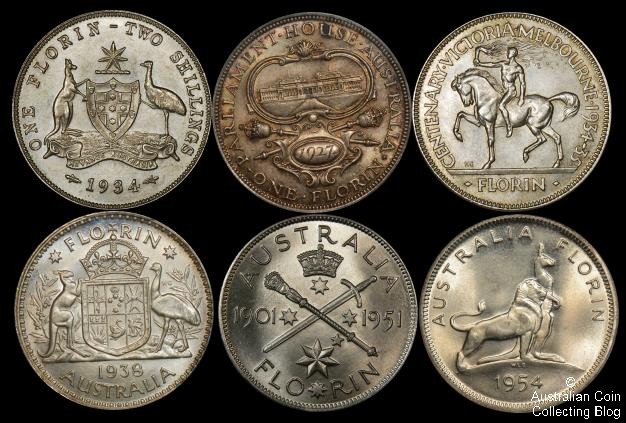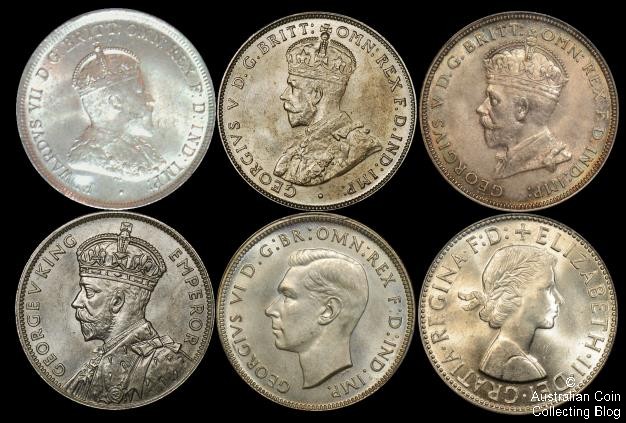Perhaps you’ve been digging in the garden and turned up a silvery coin, about the size of a 20 cent coin. Or maybe you’re at your grandparents and they’ve given you some coins to look at and among them are some unfamiliar looking coins, again the size of a 20 cent. One side has a kangaroo and emu facing each other across a shield. Above or below the kangaroo and emu might be the word “florin” and a date. The other side has the portrait of a young woman, or perhaps a man. If it’s a man he might be bare headed or he might have a crown. What you’ve got in your hands is a florin.
Florins, are 20 cent sized silver coins that also weigh the same as a 20 cent coin (11.3 grams). Florins circulated in Australia before we changed over to decimal currency in 1966. They were worth two shillings and were known as “two bob”, 10 florins made up a pound and there were 24 pennies to each florin. Back in 1960 the average wage was nearly 18 pounds and a loaf of bread cost 18 pence, so one florin would buy you a loaf of bread and give you sixpence change. Compare that to 2013 where the average cost of a loaf is $3.00 and you get the idea that this one silver coin had the purchasing power of nearly $4 in 1960. So if you’ve found some old Australian florins you’re probably wondering what are they worth? Well here’s what you need to do to work that out.
Don’t Clean Them
This may seem a little strange but the first thing you can do to determine the value of your florins is to under no circumstances clean them. But, I hear you say, they are dirty and grotty and they’d look so much nicer if they were shiny. Well, you might think that, but coin collectors being the funny lot they are LOVE coins in original condition. And once you clean a coin it’s no longer original and it’s not as attractive to them. One careless scrub with your dish scourer can instantly turn a florin that might be worth $50 to a coin collector into a $4 coin that’s only fit for the silver melt bucket. So, let me say it again, DONT CLEAN YOUR OLD FLORINS.
Sort Them Into Two Piles By Date
If you’re lucky enough to have more than one florin then you need to sort them into two piles. Look for the date on each coin, it will be on the side with the kangaroo and emu and at the bottom of the coin. Above I’ve (rather helpfully) created an image of the reverses (or tails sides) of all the Australian florins you’re likely to see. Note that usually the date is at the bottom but on some of the commemorative coins (the ones with the different designs) the date moves about a bit.
Anyway, back onto sorting the coins. On your left, make a pile of all the coins with a date BEFORE 1946. On your right make a pile of all the coins with a date with 1946 and later. Once you’re done sorting look at the two piles. The one on the left is 92.5% silver (also known as sterling silver) and those florins are known as “pre” florins. The one on the right is 50% silver and those florins are known as “post” florins. So, if nothing else the old florins you’ve found are worth something in silver. How much exactly? Well, the “pre” florins have about 1/3 of an ounce of silver in them and at the time of writing (May 2014) they were worth AU$7.09 each. And the post florins? They have 0.1818 of an ounce of silver in each one and at the time of writing they were worth AU$3.83 each.
You’re probably thinking, great, these florins are actually worth something just because of the silver in them! And, yes, that is great but before you rush off to the local silver merchant to have them melted down we need to take a MUCH closer look at the dates on each coin.
Look at the Dates On the Left Pile
Some florin dates and designs are worth more than others. Usually this is because of lower mintages and some other factors that we wont bother going into now. Examine the dates of each coin in the pile to your left (they are the ones dated BEFORE 1946). Put aside any of these dates:
- 1910 Florin
- 1914H Florin
- 1915 and 1915H florins
- 1932 Florin
- 1933 Florin
- 1934-5 Centenary Florin
- 1939 Florin
If you find any of those then congratulations they are all worth MORE than the silver they contain. Mostly at least DOUBLE the silver content. And if you’re really in luck and one of those old florins is dated 1932 then you’ve really scored. Those coins are worth at least $100 regardless of how worn they are. If you’re STUPENDOUSLY lucky then you’ve found a florin dated 1934-5 that looks very different to the others, showing someone riding a horse on the tails side of the coin rather than the usual kangaroo and emu. These are Centennial Florins and usually worth at least $200-$300 regardless of condition. In the earlier image of the tails sides of all the Australian florins the Centenary Florin reverse is the one at the top right.
While you’re looking at your “pre” florins it’s highly likely that you’ll see some that have a picture of a building on the “tails” side of the coin and are dated 1927. These are known as Parliament florins and were the first commemorative coins issued in Australia. You’ll probably notice that the guy on the “heads” side of these 1927 coins looks a little different to all the others too. If you look at the image below you can see the “heads” side of Parliament florins at the top right. Despite being pretty coins Parliament florins are, a bit sadly, usually only worth the silver they contain unless they are in “mint” condition. Mint condition is basically what a coin looked like the day it was made. And don’t go thinking that giving a coin a quick polish to make it shiny restores it to “mint” condition. This polishing is easily picked by experienced coin collectors and dealers and your polish has effectively ruined the coin.
Look at the Coins on the Right Pile
For “post” florins the date is not really the determining factor in the value of the coin. It’s what’s known as “condition” or “grade”. If a “post” florin is uncirculated then it can be worth more than the silver it contains. If it’s not, well almost all of them are really only worth the silver content. How can you tell the grade of a florin? Well, that’s not an easy topic that can be explained in this article. I’d suggest taking them to a reputable coin dealer and asking him or her to offer a grade on them. Some dealers won’t do this for free though. Or alternatively look at the coins they are selling and compare yours to those. Another option is to take good clear images of the coins and post them up onto a coin forum for Australian coins or maybe even our own Facebook page and ask for a grade. If you’re lucky people will offer you an opinion on both grade and potential value.
There’s one warning I must give about grading. It is a difficult art and just a few blemishes that are not even noticed by the coin grading novice can render what you believe to be a pristine coin into a coin only fit to be sold for silver value and sometimes this is difficult to pick in hand or from a photo or image.
What Next?
If you’ve got to this point you’ll have put aside any coins that are worth more than the others and you’ll have a pile of “pre” and “post” florins that we’ll call “bullion florins”. You can work out what the silver value of the “bullion florins” is by using our silver coin calculator here. Remember though, if you try to sell those coins to a coin dealer or silver merchant they won’t offer you the full silver value, because they need to make a profit. If you try selling them on an online auction site (like eBay) you might get the full silver value but of course you’ll need to pay the auction site fees.
So what about the other dates that we’ve decided are worth more? Well the values of those is almost entirely dependent on the grade. As I’ve said already you can get grade opinions from coin dealers or online forums. But remember opinions are just that, opinions, and will only serve to give you some idea of the value of your coins. Another option is to buy an Australian Coin Catalogue and armed with that and some grading skills you can get some idea of value. Let me give you two great big tips though. First, the values in coin catalogues are RETAIL VALUES and you’ll almost never get offered those prices if you try to sell your coins. Actually if you try to sell coins to a dealer you’ll be lucky to get HALF of what the values are in a a catalogue.
Second, coin catalogues include prices for coins known as “specimens” and “proofs” and for Australian florins the values of those can have as many digits as phone numbers. Those values can be alluring and it’s tempting to think that the florins you’ve found are “proofs” or “specimens” but they almost certainly are not. Nothing will upset a coin dealer more quickly and thoroughly when you’re trying to sell some coins to him and you insist that they are proofs or specimens in an attempt to get more for your coins. It won’t work so don’t try it.
If you decide to sell your found florins to a coin dealer they’ll grade them for you and give you an offer for them. But, again, remember they need to made a profit so don’t expect to get rich. If you want to try selling them yourself using an online auction site then take good clear images of the coins and list them up and let the market decide their grade and value.
I Don’t Want to Sell My Florins, I Want to Keep Them!
If you decide to keep your florins then great, welcome to the world of coin collecting. I strongly suggest read our coin storage recommendations. It would be a shame to have spent all this time working out the florins you found are worth real money and then to have them ruined by choosing the wrong storage system.

